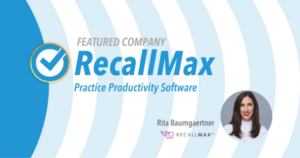Storytelling: The Key to Improved Case Acceptance

As a dental office administrator, you know it can be challenging to convince patients to sign up for recommended treatment plans or keep regular visits when they’re not in pain. This is particularly true for preventive maintenance and re-care appointments. It might be the most frustrating feeling knowing a nightmare is going on in a patient’s mouth, but because they aren’t in pain, they refuse treatment.
We need to find better ways of explaining a patient’s oral health conditions, so they can choose to do the right thing for their smile’s future.
One of the best ways we can do this is through storytelling or analogies.
Patients might not always understand what’s going on in their own mouths – especially if you use clinical terminology that sounds confusing. But when you use an analogy instead, patients will start coming around to the idea that they need your help. Routine maintenance stories related to household upkeep or automobile maintenance are always relatable to patients. For instance, changing the oil on a car is a common experience with which most people can identify. This can be used to illustrate the importance and cost-effectiveness of preventive care visits.
When patients claim that a visit with the hygienist is unnecessary because they don’t feel any pain, they’ll likely put it off. “It’s just a cleaning.” We’ve heard it a thousand times. But we know that putting off routine upkeep leads to more complicated and expensive procedures that our patients would much rather avoid (the problem is they don’t understand it yet). So, to better illustrate this point, use the analogy of getting your car’s oil changed – it’s a routine maintenance task that helps prevent more significant problems from developing.
You could even use the following story to help your patients understand what is at risk:
“Let’s think of your mouth like a brand-new car. The manufacturer recommends getting your car serviced every 3,000 miles. If your car seems to be working fine, you might consider putting off the oil change. But then you run the risk of an engine light coming on, or maybe your car begins having trouble within the next three to four months. Neglecting regular maintenance can be expensive and risky. If you had taken your car for regular maintenance, the service technician could have identified simple issues like a faulty oil filter or low coolant levels. You could have gotten them fixed by replacing the filter and adding fluids. If left unattended, these minor issues can escalate into major ones, causing extensive damage to your car and leading to expensive repairs. After an oil change, you get a list of what they are seeing and an action plan for maintaining the car to run properly.
“A preventive dental visit is like an oil change for your car. We not only clean your teeth but also thoroughly examine each tooth and the supporting gum and bone structures for any issues or potential problems. Our goal is to inform you as soon as possible if anything requires attention or any necessary investments to maintain your teeth and keep you smiling.”
Imagine your patient’s reaction to the service technician if they decided not to go forward with the oil change or replace the filter. They’d probably say something like, “Are you sure? Do you know what will probably happen to you on the road if you don’t take care of this soon?”
If you’re a true advocate for your patients, you know how crucial it is to communicate clearly and effectively why they should accept the treatment your team is recommending. It’s up to you to provide your patients with all the necessary information to make informed decisions about their health. It’s important to prioritize their well-being and emphasize the potential negative outcomes of delayed treatment. You could explain the consequences of not acting soon enough like this:
“We have observed patients with conditions similar to yours who opted not to undergo care. They ended up facing more complicated and much more expensive procedures in the long run.” When you use stories to get the message across, patients have a better understanding of what the stakes are. Tell them, “It reduces overall costs when you choose to intervene earlier rather than waiting until treatment becomes more complicated and costly.”
Practice makes perfect. It’s beneficial to practice your storytelling techniques with your teammates regularly. Role play and make up scenarios in which a patient is defiantly putting off necessary treatment, and then come up with different ways you and your team can convince each other to move toward getting care. Rehearse each scenario out loud until you feel confident enough to repeat them without hesitation. Additionally, it’s essential to tailor your discussions to the specific patient with whom you’re communicating.
About the Author

Joanne Miles is one of Production Dentist Academy’s investment-grade practice business advisors, sometimes referred to as the Swiss Army knife of dentistry. As an experienced dental practice growth leader with decades of nationwide experience, Joanne is passionate about sharing proven methods to help dentists and their teams grow. In addition to business operations, she strongly focuses on team building, patient experience, and leadership development. Joanne is a lifetime member of AADOM and received her Mastership distinction in 2021.







